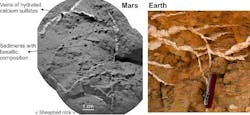Los Alamos, NM--A trail of minerals that could point to the prior presence of water on Mars has been tracked by the Curiosity rover. Los Alamos National Laboratory (LANL) and French Space Agency researchers from the Mars Science Laboratory's ChemCam team said the ChemCam has detected veins of gypsum running through an area known as Yellowknife Bay, located some 700 m away from where the Curiosity Rover landed five months ago.
"These veins are composed mainly of hydrated calcium sulfate, such as bassanite or gypsum," said ChemCam team member Nicolas Mangold of the Laboratoire de Planétologie et Géodynamique de Nantes, in Nantes, France. "On Earth, forming veins like these requires water circulating in fractures." The presence of gypsum and its cousin, bassinite, along with physical evidence of alluvial flow patterns previously seen during the Mars Science Laboratory mission, could indicate that the Yellowknife Bay area once was home to ponds created by runoff or subsurface water that had percolated to the surface, said ChemCam team member Sam Clegg of LANL.
Clegg and his colleagues first noticed the possibility of a gypsum signature weeks ago when ChemCam's spectrometer recorded an increasing amount of calcium and a corresponding decrease in the silicon composition of a sample. Gypsum, a sedimentary rock, is made of calcium sulfate with bound water, while most of the rocks sampled so far on Mars are primarily composed of silicon. The change in composition indicated to the team that they were seeing something new in Martian geology.
The ChemCam instrument fires a powerful laser to vaporize rocks and then uses its spectrometer to analyze the samples. Because the laser can fire several pulses to sample rock situated below layers of surface dust, the ChemCam team was able to catch their first signs of calcium before anyone could actually see it. However, the instrument's camera later was able to view the pale veins of mineral after the rock surface had been dusted off by laser blasts.
Because water is a necessary ingredient of life as we know it here on Earth, the findings are exciting. Meanwhile, members of the ChemCam team have shifted from Mars time to Earth time and a pair of control rooms while guiding ChemCam's activities. Since November, the team has alternated operation of the instrument back and forth between control rooms in Toulouse, France, and Los Alamos, NM. The arrangement allows the team to communicate back and forth, while sharing direct responsibility for the instrument between the Los Alamos and French team members. The arrangement provides synergy and allows for periods of hands-on activity and much needed rest.
ChemCam is a collaboration between research organizations within the United States and France. More than 45 scientists, students and other personnel are currently active in North America and Europe on the ChemCam team. A dozen scientists, engineers, and students are leading LANL operations of ChemCam. The ChemCam system is one of 10 instruments mounted on the mission's Curiosity rover.
SOURCE: Los Alamos National Laboratory; http://www.lanl.gov/newsroom/news-releases/2013/January/01.15-chemcam-follows-yellowknife-road.php

